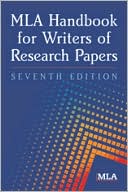
Goals
After reviewing this module, you will:
What is a citation? Most academic work draws upon the works of others; therefore, citing your sources is an important part of the scholarly writing process.
Citations include the key elements that allow your sources to be identified and located. These elements vary depending on the type of resource.
There are several reasons to cite yor sources:
Direct link to video: https://www.kaltura.com/tiny/gbzey
Introduction
 |
 |
| The MLA Handbook for Writers of Research Papers 7th Edition, created by the Modern Language Association, is the preferred style manual for students in English Departments to use in preparing their research papers. While there are other citation styles you may use in other classes, we will focus on it here because it is used in most humanities fields. | The rules of APA Style®, detailed in the Publication Manual of the American Psychological Association, offer sound guidance for writing with simplicity, power, and concision. APA Style has been adapted by many disciplines and is used by writers around the world. |
| Click here for a tutorial on how to cite resources using MLA style. | Click here for a tutorial on how to cite resources using APA style. |
It's important to cite your sources for the reasons mentioned in the previous video; however, the most important reason to use citations is to avoid accidental plagiarism. Because plagiarism can be a tricky subject to master, let's look at a great plagiarism tutorial from Vaughan Memorial Library at Acadia University.
EasyBib is a free, online-based citation manage that helps you cite in any style guide. Use this Instructional Guide to explore the tool and get a feel for EasyBib.
While EasyBib is a fantastic resource, your professor is the final authority on style issues. Sometimes a professor will modify the style to accomodate his or her needs, so check with your professor for any problems.
For more information on APA and MLA Citations, check out the following pages:
Click here to proceed to the next page of the module, Plagiarism and Academic Honesty.
From Bobish and Jacobson's OpenSUNY's Information Literacy User's Guide (pg. 55- 61)
Take a look at some examples of citations by clicking the button below. You can see that there are differences between citation styles, and that each information format contains different elements. When you try to determine whether a citation is for a book, book chapter or journal, think about the elements inherent in each of these formats.
After you finish exploring the elements of a citation, take the online quiz by clicking the button below. In this exercise, you will choose the type of resource that matches the citation. Don't worry about scoring - this is a learning exercise that will help you master the different parts of a citation.